Employee Relations Analysis: Conflict and Negotiation Strategies
VerifiedAdded on 2020/02/24
|26
|5738
|43
Report
AI Summary
This report provides a comprehensive analysis of employee relations, specifically within the context of the National Health Service (NHS). It begins by exploring different frames of reference (unitary and pluralistic) in employment relations, examining how changes in trade unionism have affected these dynamics in the UK. The report then identifies the roles of key players like employers, employees, trade unions, employer associations, and the government. Part 2 delves into conflict resolution procedures within the NHS, detailing different conflict situations and evaluating the effectiveness of various strategies. It also examines negotiation processes, strategies, and their impact on conflict resolution. Finally, the report assesses the influence of the EU on industrial democracy, employee participation methods, and the impact of human resource management approaches on employee relations. The report uses examples from the NHS to illustrate its points and provides a thorough overview of managing employee relationships.
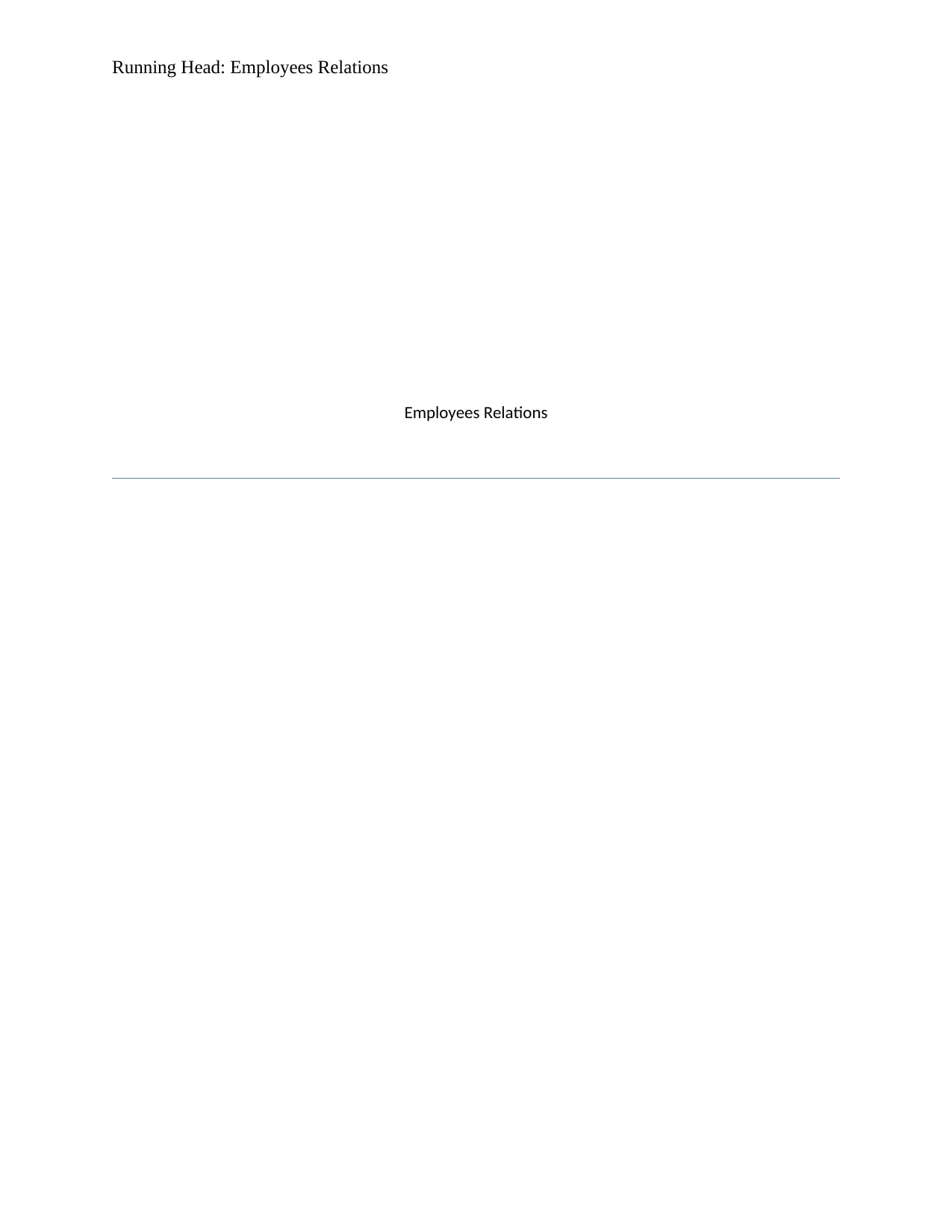
Running Head: Employees Relations
Employees Relations
Employees Relations
Paraphrase This Document
Need a fresh take? Get an instant paraphrase of this document with our AI Paraphraser
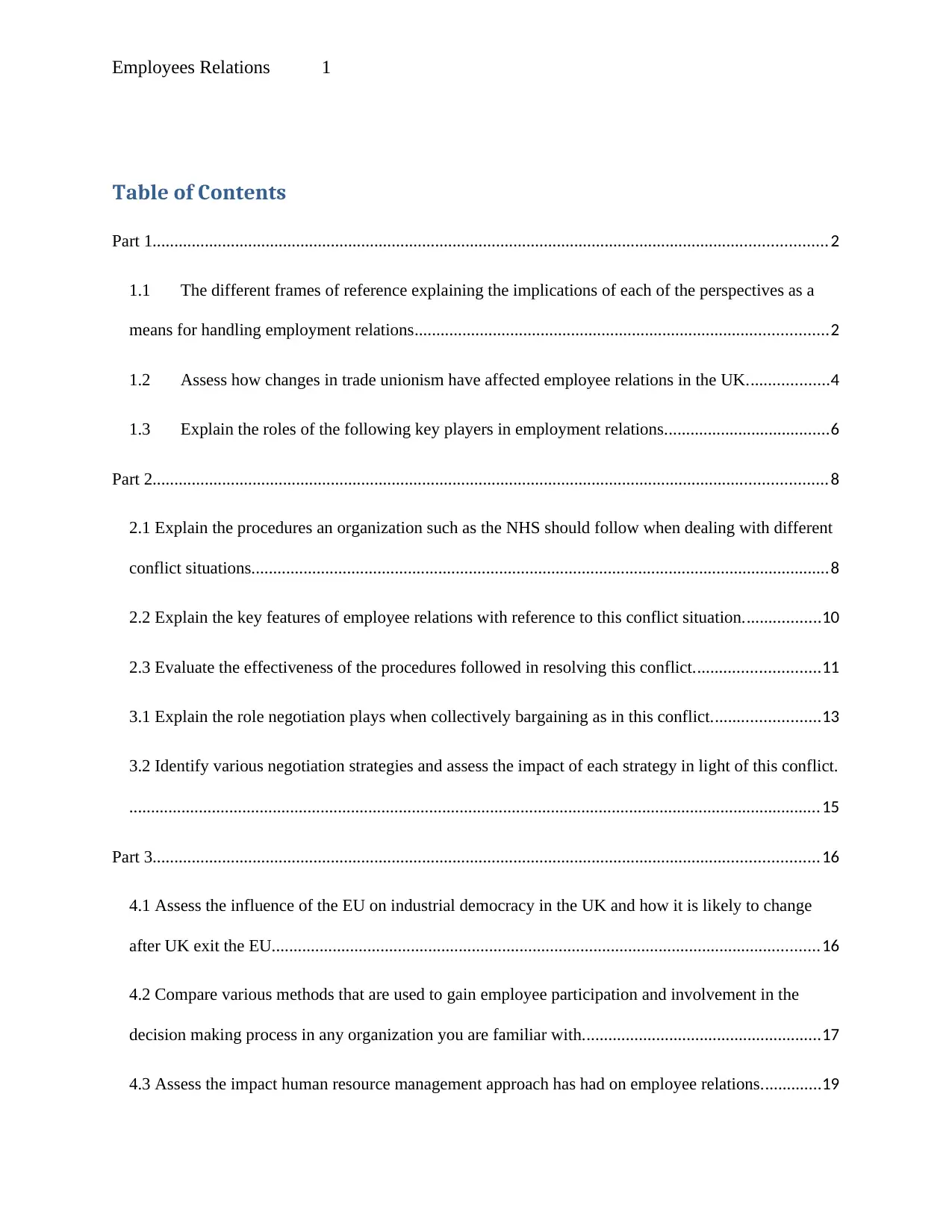
Employees Relations 1
Table of Contents
Part 1...........................................................................................................................................................2
1.1 The different frames of reference explaining the implications of each of the perspectives as a
means for handling employment relations...............................................................................................2
1.2 Assess how changes in trade unionism have affected employee relations in the UK...................4
1.3 Explain the roles of the following key players in employment relations......................................6
Part 2...........................................................................................................................................................8
2.1 Explain the procedures an organization such as the NHS should follow when dealing with different
conflict situations.....................................................................................................................................8
2.2 Explain the key features of employee relations with reference to this conflict situation..................10
2.3 Evaluate the effectiveness of the procedures followed in resolving this conflict.............................11
3.1 Explain the role negotiation plays when collectively bargaining as in this conflict.........................13
3.2 Identify various negotiation strategies and assess the impact of each strategy in light of this conflict.
...............................................................................................................................................................15
Part 3.........................................................................................................................................................16
4.1 Assess the influence of the EU on industrial democracy in the UK and how it is likely to change
after UK exit the EU..............................................................................................................................16
4.2 Compare various methods that are used to gain employee participation and involvement in the
decision making process in any organization you are familiar with.......................................................17
4.3 Assess the impact human resource management approach has had on employee relations..............19
Table of Contents
Part 1...........................................................................................................................................................2
1.1 The different frames of reference explaining the implications of each of the perspectives as a
means for handling employment relations...............................................................................................2
1.2 Assess how changes in trade unionism have affected employee relations in the UK...................4
1.3 Explain the roles of the following key players in employment relations......................................6
Part 2...........................................................................................................................................................8
2.1 Explain the procedures an organization such as the NHS should follow when dealing with different
conflict situations.....................................................................................................................................8
2.2 Explain the key features of employee relations with reference to this conflict situation..................10
2.3 Evaluate the effectiveness of the procedures followed in resolving this conflict.............................11
3.1 Explain the role negotiation plays when collectively bargaining as in this conflict.........................13
3.2 Identify various negotiation strategies and assess the impact of each strategy in light of this conflict.
...............................................................................................................................................................15
Part 3.........................................................................................................................................................16
4.1 Assess the influence of the EU on industrial democracy in the UK and how it is likely to change
after UK exit the EU..............................................................................................................................16
4.2 Compare various methods that are used to gain employee participation and involvement in the
decision making process in any organization you are familiar with.......................................................17
4.3 Assess the impact human resource management approach has had on employee relations..............19

Employees Relations 2
References.................................................................................................................................................21
References.................................................................................................................................................21
⊘ This is a preview!⊘
Do you want full access?
Subscribe today to unlock all pages.

Trusted by 1+ million students worldwide
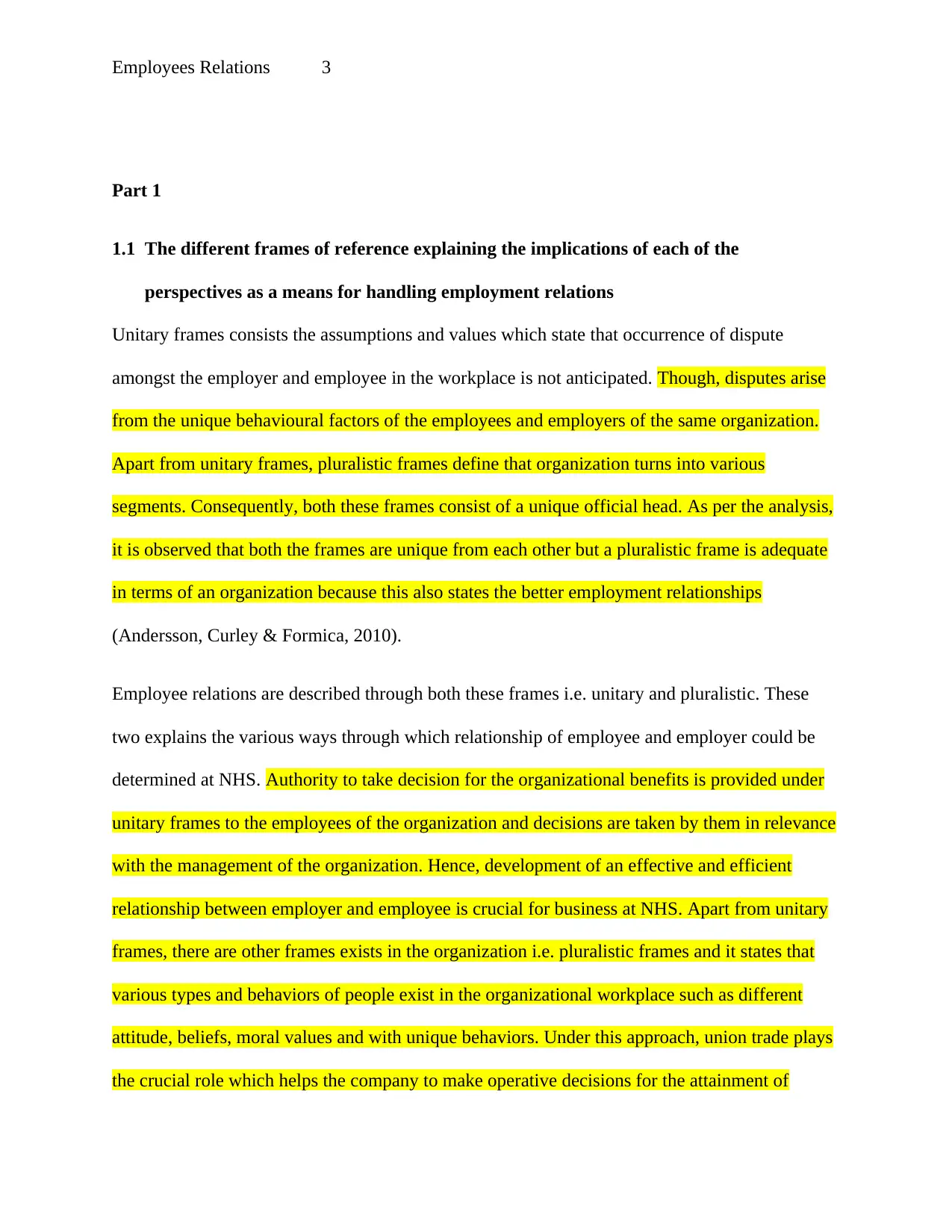
Employees Relations 3
Part 1
1.1 The different frames of reference explaining the implications of each of the
perspectives as a means for handling employment relations
Unitary frames consists the assumptions and values which state that occurrence of dispute
amongst the employer and employee in the workplace is not anticipated. Though, disputes arise
from the unique behavioural factors of the employees and employers of the same organization.
Apart from unitary frames, pluralistic frames define that organization turns into various
segments. Consequently, both these frames consist of a unique official head. As per the analysis,
it is observed that both the frames are unique from each other but a pluralistic frame is adequate
in terms of an organization because this also states the better employment relationships
(Andersson, Curley & Formica, 2010).
Employee relations are described through both these frames i.e. unitary and pluralistic. These
two explains the various ways through which relationship of employee and employer could be
determined at NHS. Authority to take decision for the organizational benefits is provided under
unitary frames to the employees of the organization and decisions are taken by them in relevance
with the management of the organization. Hence, development of an effective and efficient
relationship between employer and employee is crucial for business at NHS. Apart from unitary
frames, there are other frames exists in the organization i.e. pluralistic frames and it states that
various types and behaviors of people exist in the organizational workplace such as different
attitude, beliefs, moral values and with unique behaviors. Under this approach, union trade plays
the crucial role which helps the company to make operative decisions for the attainment of
Part 1
1.1 The different frames of reference explaining the implications of each of the
perspectives as a means for handling employment relations
Unitary frames consists the assumptions and values which state that occurrence of dispute
amongst the employer and employee in the workplace is not anticipated. Though, disputes arise
from the unique behavioural factors of the employees and employers of the same organization.
Apart from unitary frames, pluralistic frames define that organization turns into various
segments. Consequently, both these frames consist of a unique official head. As per the analysis,
it is observed that both the frames are unique from each other but a pluralistic frame is adequate
in terms of an organization because this also states the better employment relationships
(Andersson, Curley & Formica, 2010).
Employee relations are described through both these frames i.e. unitary and pluralistic. These
two explains the various ways through which relationship of employee and employer could be
determined at NHS. Authority to take decision for the organizational benefits is provided under
unitary frames to the employees of the organization and decisions are taken by them in relevance
with the management of the organization. Hence, development of an effective and efficient
relationship between employer and employee is crucial for business at NHS. Apart from unitary
frames, there are other frames exists in the organization i.e. pluralistic frames and it states that
various types and behaviors of people exist in the organizational workplace such as different
attitude, beliefs, moral values and with unique behaviors. Under this approach, union trade plays
the crucial role which helps the company to make operative decisions for the attainment of
Paraphrase This Document
Need a fresh take? Get an instant paraphrase of this document with our AI Paraphraser
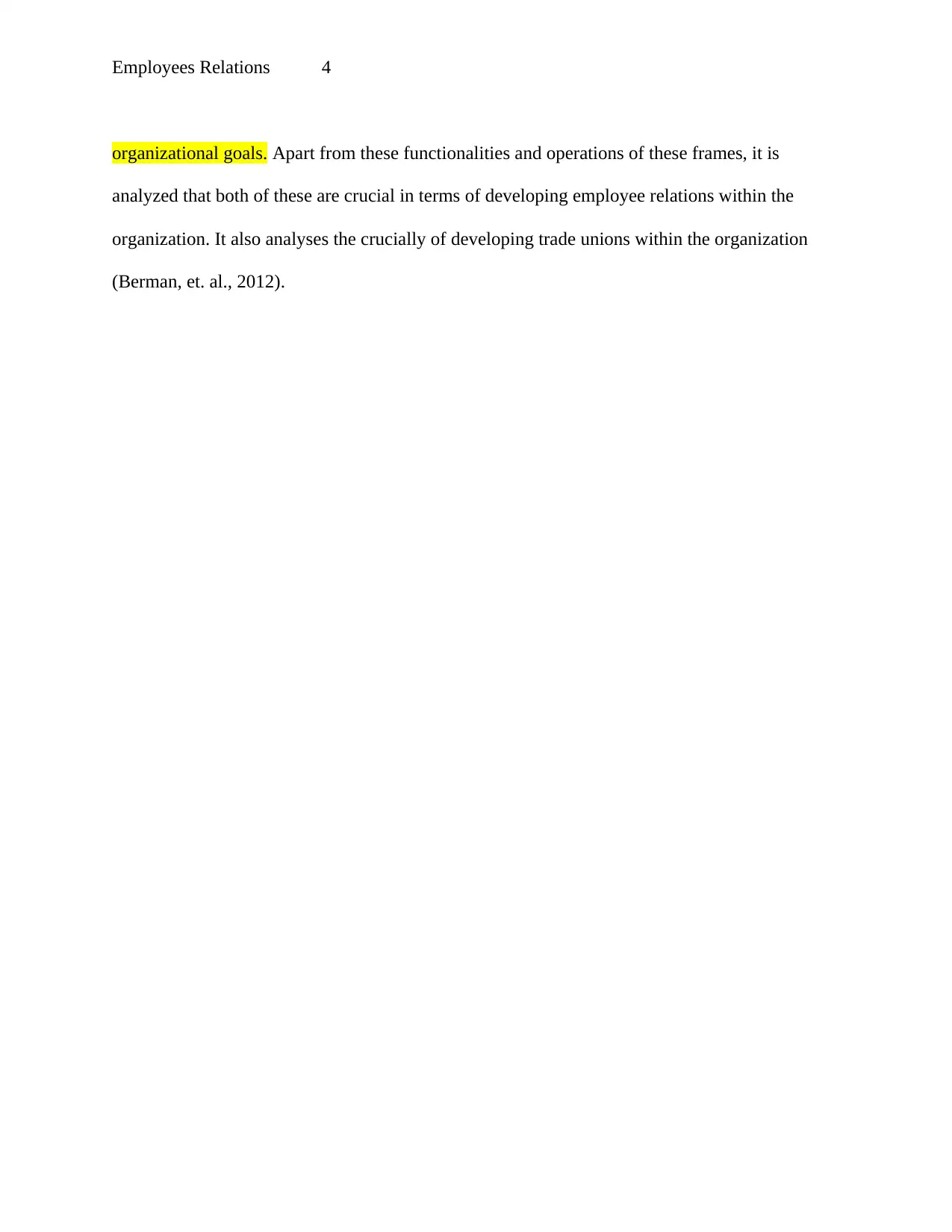
Employees Relations 4
organizational goals. Apart from these functionalities and operations of these frames, it is
analyzed that both of these are crucial in terms of developing employee relations within the
organization. It also analyses the crucially of developing trade unions within the organization
(Berman, et. al., 2012).
organizational goals. Apart from these functionalities and operations of these frames, it is
analyzed that both of these are crucial in terms of developing employee relations within the
organization. It also analyses the crucially of developing trade unions within the organization
(Berman, et. al., 2012).
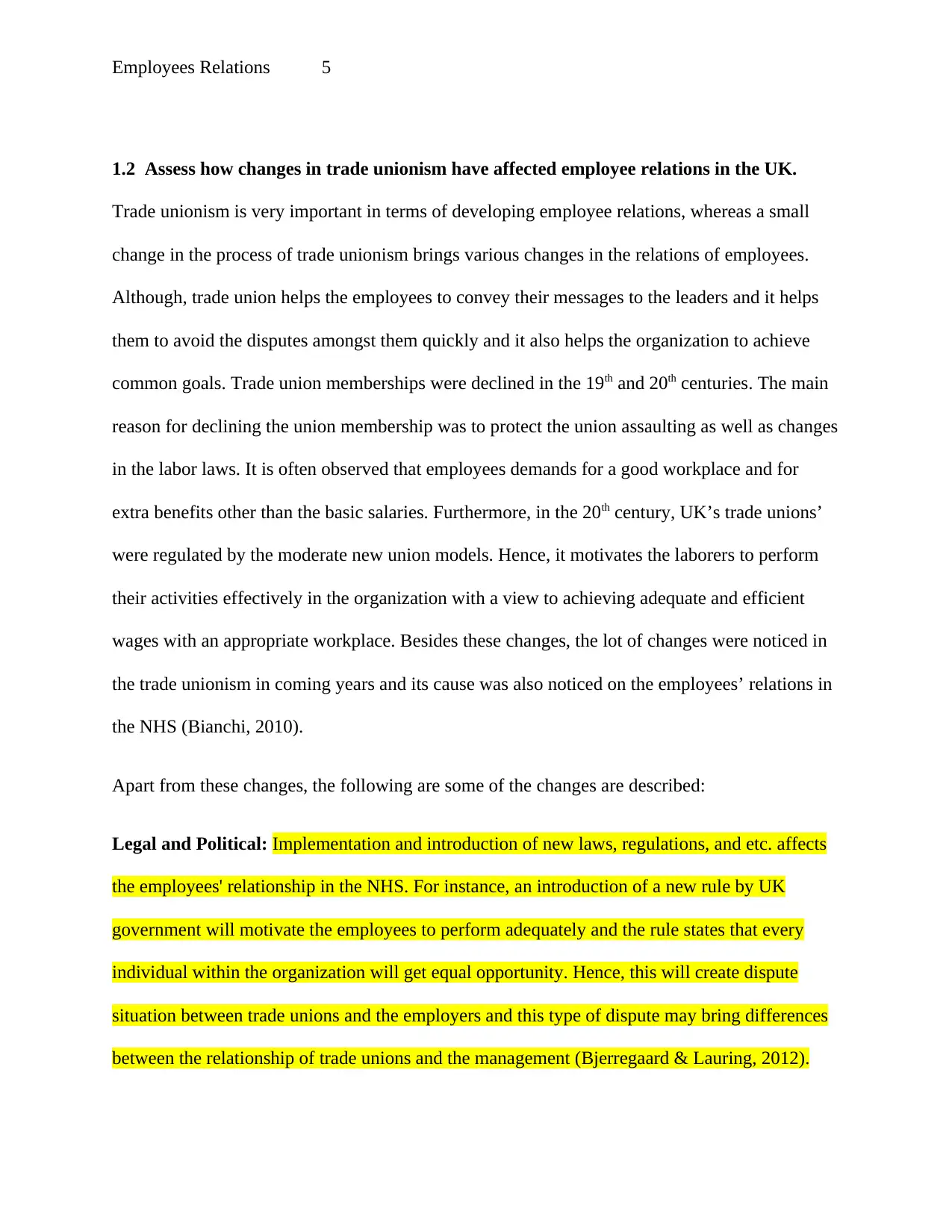
Employees Relations 5
1.2 Assess how changes in trade unionism have affected employee relations in the UK.
Trade unionism is very important in terms of developing employee relations, whereas a small
change in the process of trade unionism brings various changes in the relations of employees.
Although, trade union helps the employees to convey their messages to the leaders and it helps
them to avoid the disputes amongst them quickly and it also helps the organization to achieve
common goals. Trade union memberships were declined in the 19th and 20th centuries. The main
reason for declining the union membership was to protect the union assaulting as well as changes
in the labor laws. It is often observed that employees demands for a good workplace and for
extra benefits other than the basic salaries. Furthermore, in the 20th century, UK’s trade unions’
were regulated by the moderate new union models. Hence, it motivates the laborers to perform
their activities effectively in the organization with a view to achieving adequate and efficient
wages with an appropriate workplace. Besides these changes, the lot of changes were noticed in
the trade unionism in coming years and its cause was also noticed on the employees’ relations in
the NHS (Bianchi, 2010).
Apart from these changes, the following are some of the changes are described:
Legal and Political: Implementation and introduction of new laws, regulations, and etc. affects
the employees' relationship in the NHS. For instance, an introduction of a new rule by UK
government will motivate the employees to perform adequately and the rule states that every
individual within the organization will get equal opportunity. Hence, this will create dispute
situation between trade unions and the employers and this type of dispute may bring differences
between the relationship of trade unions and the management (Bjerregaard & Lauring, 2012).
1.2 Assess how changes in trade unionism have affected employee relations in the UK.
Trade unionism is very important in terms of developing employee relations, whereas a small
change in the process of trade unionism brings various changes in the relations of employees.
Although, trade union helps the employees to convey their messages to the leaders and it helps
them to avoid the disputes amongst them quickly and it also helps the organization to achieve
common goals. Trade union memberships were declined in the 19th and 20th centuries. The main
reason for declining the union membership was to protect the union assaulting as well as changes
in the labor laws. It is often observed that employees demands for a good workplace and for
extra benefits other than the basic salaries. Furthermore, in the 20th century, UK’s trade unions’
were regulated by the moderate new union models. Hence, it motivates the laborers to perform
their activities effectively in the organization with a view to achieving adequate and efficient
wages with an appropriate workplace. Besides these changes, the lot of changes were noticed in
the trade unionism in coming years and its cause was also noticed on the employees’ relations in
the NHS (Bianchi, 2010).
Apart from these changes, the following are some of the changes are described:
Legal and Political: Implementation and introduction of new laws, regulations, and etc. affects
the employees' relationship in the NHS. For instance, an introduction of a new rule by UK
government will motivate the employees to perform adequately and the rule states that every
individual within the organization will get equal opportunity. Hence, this will create dispute
situation between trade unions and the employers and this type of dispute may bring differences
between the relationship of trade unions and the management (Bjerregaard & Lauring, 2012).
⊘ This is a preview!⊘
Do you want full access?
Subscribe today to unlock all pages.

Trusted by 1+ million students worldwide
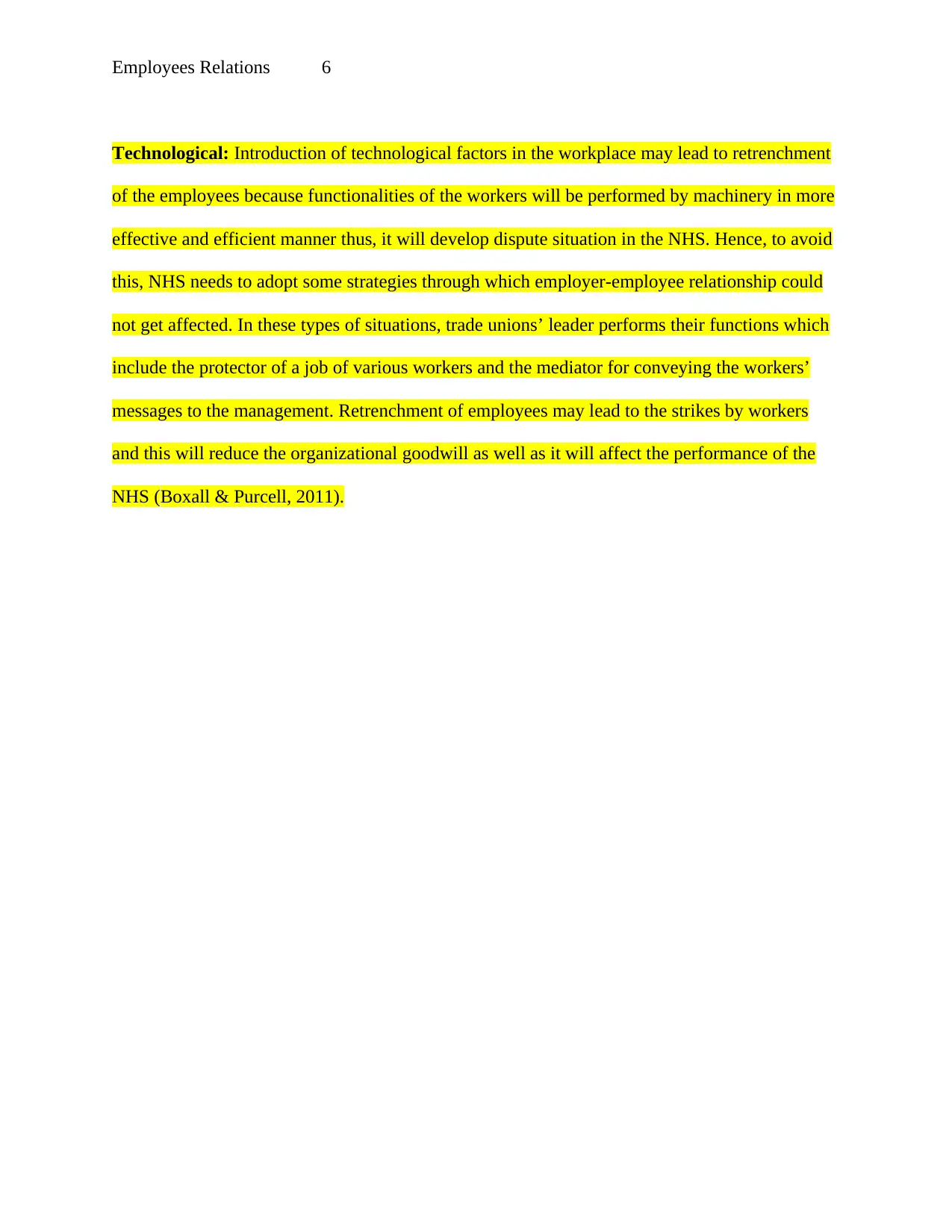
Employees Relations 6
Technological: Introduction of technological factors in the workplace may lead to retrenchment
of the employees because functionalities of the workers will be performed by machinery in more
effective and efficient manner thus, it will develop dispute situation in the NHS. Hence, to avoid
this, NHS needs to adopt some strategies through which employer-employee relationship could
not get affected. In these types of situations, trade unions’ leader performs their functions which
include the protector of a job of various workers and the mediator for conveying the workers’
messages to the management. Retrenchment of employees may lead to the strikes by workers
and this will reduce the organizational goodwill as well as it will affect the performance of the
NHS (Boxall & Purcell, 2011).
Technological: Introduction of technological factors in the workplace may lead to retrenchment
of the employees because functionalities of the workers will be performed by machinery in more
effective and efficient manner thus, it will develop dispute situation in the NHS. Hence, to avoid
this, NHS needs to adopt some strategies through which employer-employee relationship could
not get affected. In these types of situations, trade unions’ leader performs their functions which
include the protector of a job of various workers and the mediator for conveying the workers’
messages to the management. Retrenchment of employees may lead to the strikes by workers
and this will reduce the organizational goodwill as well as it will affect the performance of the
NHS (Boxall & Purcell, 2011).
Paraphrase This Document
Need a fresh take? Get an instant paraphrase of this document with our AI Paraphraser
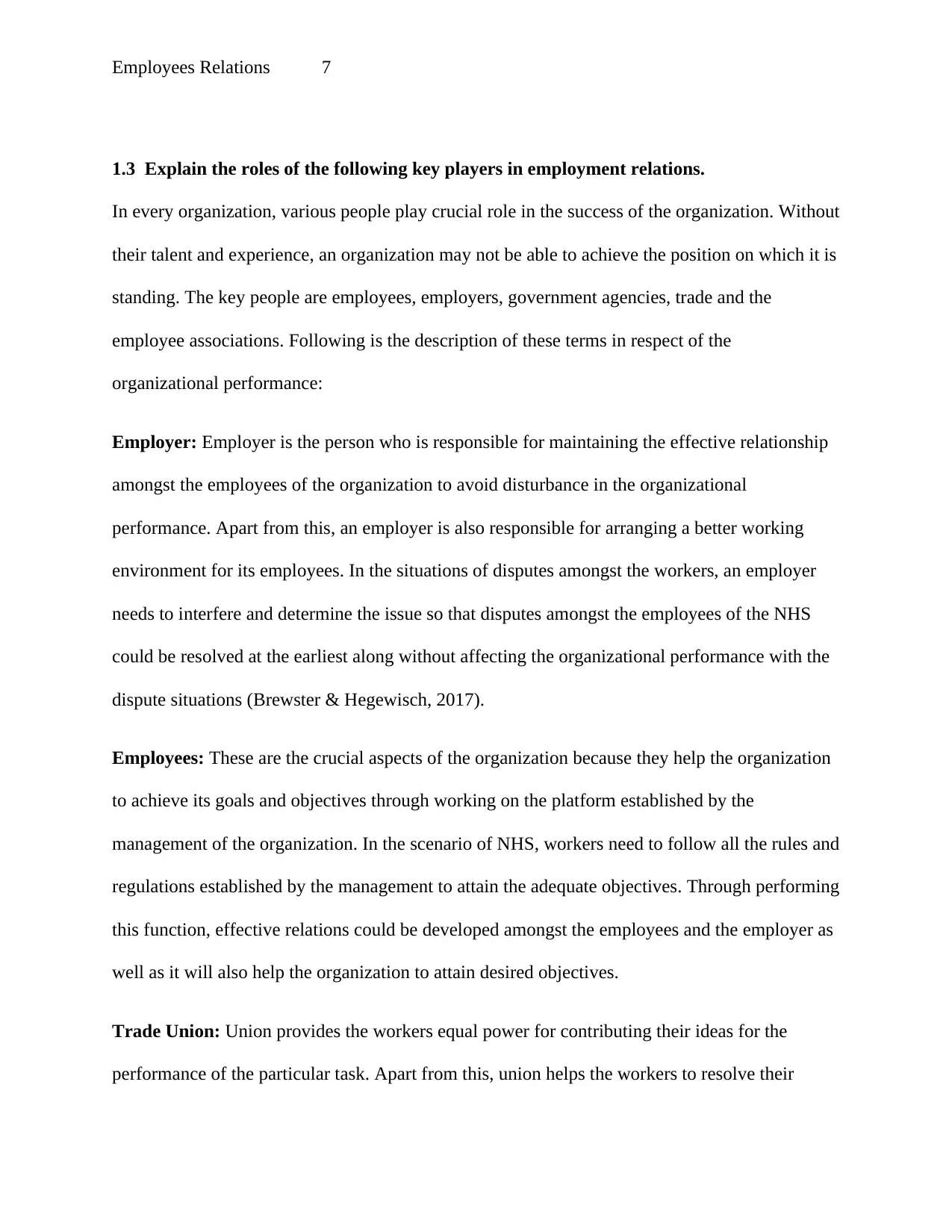
Employees Relations 7
1.3 Explain the roles of the following key players in employment relations.
In every organization, various people play crucial role in the success of the organization. Without
their talent and experience, an organization may not be able to achieve the position on which it is
standing. The key people are employees, employers, government agencies, trade and the
employee associations. Following is the description of these terms in respect of the
organizational performance:
Employer: Employer is the person who is responsible for maintaining the effective relationship
amongst the employees of the organization to avoid disturbance in the organizational
performance. Apart from this, an employer is also responsible for arranging a better working
environment for its employees. In the situations of disputes amongst the workers, an employer
needs to interfere and determine the issue so that disputes amongst the employees of the NHS
could be resolved at the earliest along without affecting the organizational performance with the
dispute situations (Brewster & Hegewisch, 2017).
Employees: These are the crucial aspects of the organization because they help the organization
to achieve its goals and objectives through working on the platform established by the
management of the organization. In the scenario of NHS, workers need to follow all the rules and
regulations established by the management to attain the adequate objectives. Through performing
this function, effective relations could be developed amongst the employees and the employer as
well as it will also help the organization to attain desired objectives.
Trade Union: Union provides the workers equal power for contributing their ideas for the
performance of the particular task. Apart from this, union helps the workers to resolve their
1.3 Explain the roles of the following key players in employment relations.
In every organization, various people play crucial role in the success of the organization. Without
their talent and experience, an organization may not be able to achieve the position on which it is
standing. The key people are employees, employers, government agencies, trade and the
employee associations. Following is the description of these terms in respect of the
organizational performance:
Employer: Employer is the person who is responsible for maintaining the effective relationship
amongst the employees of the organization to avoid disturbance in the organizational
performance. Apart from this, an employer is also responsible for arranging a better working
environment for its employees. In the situations of disputes amongst the workers, an employer
needs to interfere and determine the issue so that disputes amongst the employees of the NHS
could be resolved at the earliest along without affecting the organizational performance with the
dispute situations (Brewster & Hegewisch, 2017).
Employees: These are the crucial aspects of the organization because they help the organization
to achieve its goals and objectives through working on the platform established by the
management of the organization. In the scenario of NHS, workers need to follow all the rules and
regulations established by the management to attain the adequate objectives. Through performing
this function, effective relations could be developed amongst the employees and the employer as
well as it will also help the organization to attain desired objectives.
Trade Union: Union provides the workers equal power for contributing their ideas for the
performance of the particular task. Apart from this, union helps the workers to resolve their
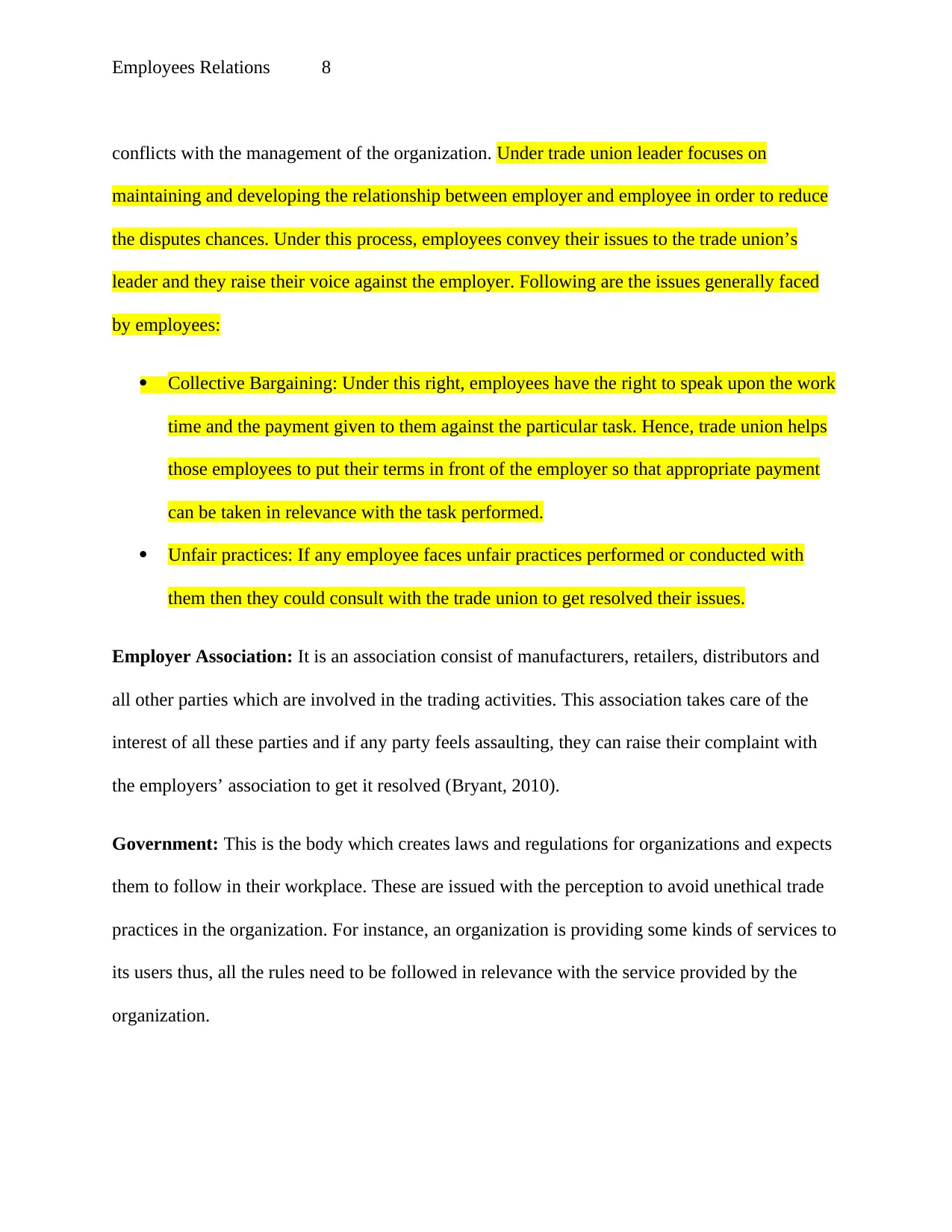
Employees Relations 8
conflicts with the management of the organization. Under trade union leader focuses on
maintaining and developing the relationship between employer and employee in order to reduce
the disputes chances. Under this process, employees convey their issues to the trade union’s
leader and they raise their voice against the employer. Following are the issues generally faced
by employees:
Collective Bargaining: Under this right, employees have the right to speak upon the work
time and the payment given to them against the particular task. Hence, trade union helps
those employees to put their terms in front of the employer so that appropriate payment
can be taken in relevance with the task performed.
Unfair practices: If any employee faces unfair practices performed or conducted with
them then they could consult with the trade union to get resolved their issues.
Employer Association: It is an association consist of manufacturers, retailers, distributors and
all other parties which are involved in the trading activities. This association takes care of the
interest of all these parties and if any party feels assaulting, they can raise their complaint with
the employers’ association to get it resolved (Bryant, 2010).
Government: This is the body which creates laws and regulations for organizations and expects
them to follow in their workplace. These are issued with the perception to avoid unethical trade
practices in the organization. For instance, an organization is providing some kinds of services to
its users thus, all the rules need to be followed in relevance with the service provided by the
organization.
conflicts with the management of the organization. Under trade union leader focuses on
maintaining and developing the relationship between employer and employee in order to reduce
the disputes chances. Under this process, employees convey their issues to the trade union’s
leader and they raise their voice against the employer. Following are the issues generally faced
by employees:
Collective Bargaining: Under this right, employees have the right to speak upon the work
time and the payment given to them against the particular task. Hence, trade union helps
those employees to put their terms in front of the employer so that appropriate payment
can be taken in relevance with the task performed.
Unfair practices: If any employee faces unfair practices performed or conducted with
them then they could consult with the trade union to get resolved their issues.
Employer Association: It is an association consist of manufacturers, retailers, distributors and
all other parties which are involved in the trading activities. This association takes care of the
interest of all these parties and if any party feels assaulting, they can raise their complaint with
the employers’ association to get it resolved (Bryant, 2010).
Government: This is the body which creates laws and regulations for organizations and expects
them to follow in their workplace. These are issued with the perception to avoid unethical trade
practices in the organization. For instance, an organization is providing some kinds of services to
its users thus, all the rules need to be followed in relevance with the service provided by the
organization.
⊘ This is a preview!⊘
Do you want full access?
Subscribe today to unlock all pages.

Trusted by 1+ million students worldwide
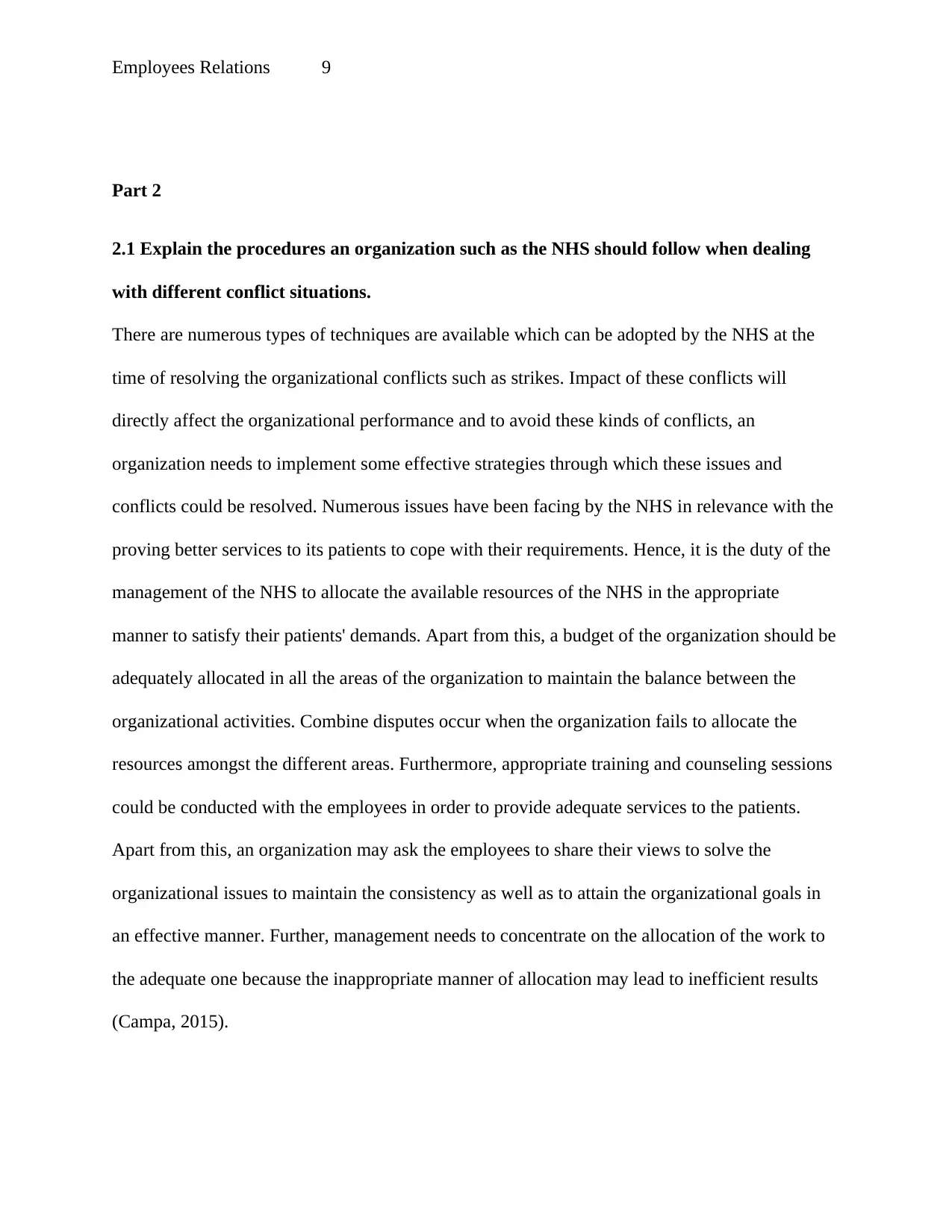
Employees Relations 9
Part 2
2.1 Explain the procedures an organization such as the NHS should follow when dealing
with different conflict situations.
There are numerous types of techniques are available which can be adopted by the NHS at the
time of resolving the organizational conflicts such as strikes. Impact of these conflicts will
directly affect the organizational performance and to avoid these kinds of conflicts, an
organization needs to implement some effective strategies through which these issues and
conflicts could be resolved. Numerous issues have been facing by the NHS in relevance with the
proving better services to its patients to cope with their requirements. Hence, it is the duty of the
management of the NHS to allocate the available resources of the NHS in the appropriate
manner to satisfy their patients' demands. Apart from this, a budget of the organization should be
adequately allocated in all the areas of the organization to maintain the balance between the
organizational activities. Combine disputes occur when the organization fails to allocate the
resources amongst the different areas. Furthermore, appropriate training and counseling sessions
could be conducted with the employees in order to provide adequate services to the patients.
Apart from this, an organization may ask the employees to share their views to solve the
organizational issues to maintain the consistency as well as to attain the organizational goals in
an effective manner. Further, management needs to concentrate on the allocation of the work to
the adequate one because the inappropriate manner of allocation may lead to inefficient results
(Campa, 2015).
Part 2
2.1 Explain the procedures an organization such as the NHS should follow when dealing
with different conflict situations.
There are numerous types of techniques are available which can be adopted by the NHS at the
time of resolving the organizational conflicts such as strikes. Impact of these conflicts will
directly affect the organizational performance and to avoid these kinds of conflicts, an
organization needs to implement some effective strategies through which these issues and
conflicts could be resolved. Numerous issues have been facing by the NHS in relevance with the
proving better services to its patients to cope with their requirements. Hence, it is the duty of the
management of the NHS to allocate the available resources of the NHS in the appropriate
manner to satisfy their patients' demands. Apart from this, a budget of the organization should be
adequately allocated in all the areas of the organization to maintain the balance between the
organizational activities. Combine disputes occur when the organization fails to allocate the
resources amongst the different areas. Furthermore, appropriate training and counseling sessions
could be conducted with the employees in order to provide adequate services to the patients.
Apart from this, an organization may ask the employees to share their views to solve the
organizational issues to maintain the consistency as well as to attain the organizational goals in
an effective manner. Further, management needs to concentrate on the allocation of the work to
the adequate one because the inappropriate manner of allocation may lead to inefficient results
(Campa, 2015).
Paraphrase This Document
Need a fresh take? Get an instant paraphrase of this document with our AI Paraphraser
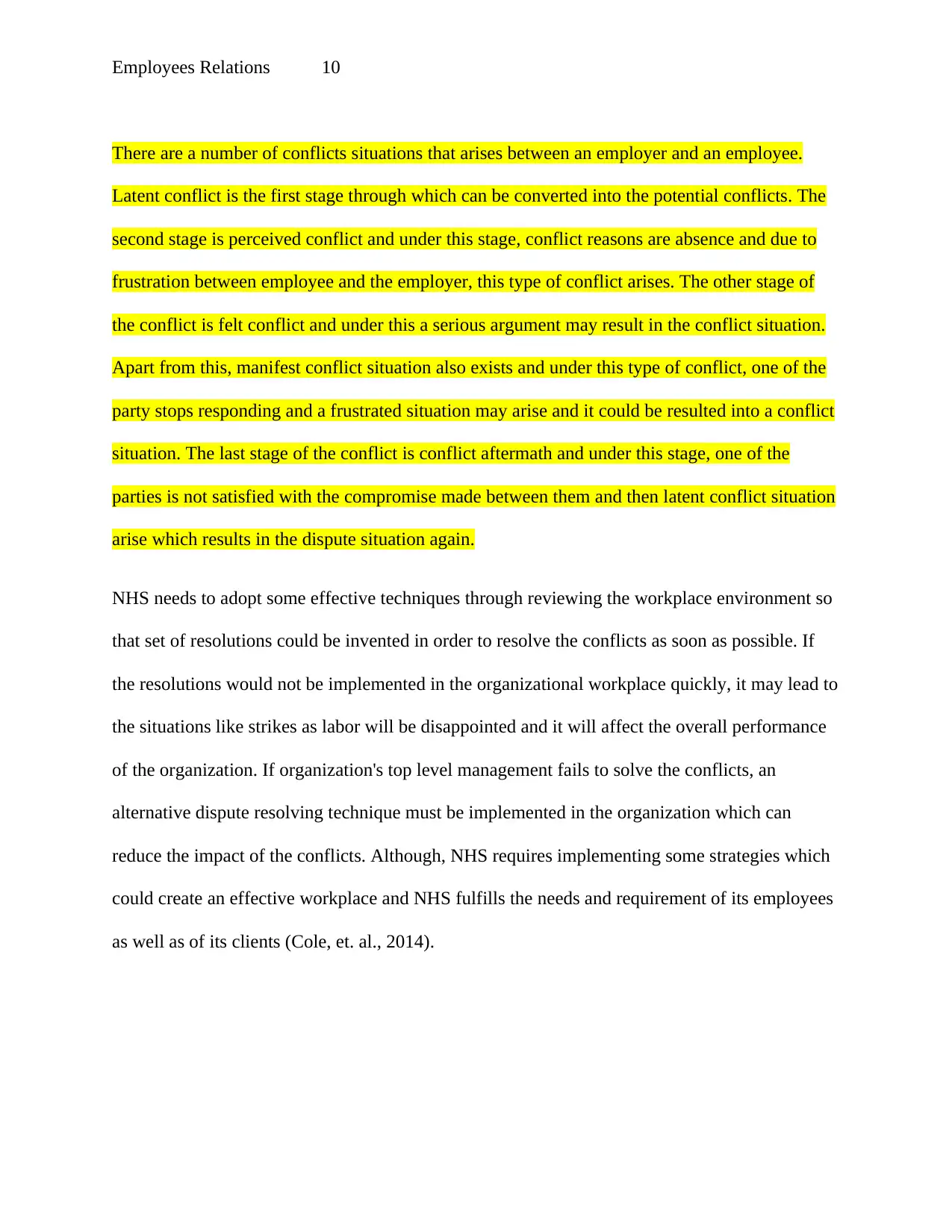
Employees Relations 10
There are a number of conflicts situations that arises between an employer and an employee.
Latent conflict is the first stage through which can be converted into the potential conflicts. The
second stage is perceived conflict and under this stage, conflict reasons are absence and due to
frustration between employee and the employer, this type of conflict arises. The other stage of
the conflict is felt conflict and under this a serious argument may result in the conflict situation.
Apart from this, manifest conflict situation also exists and under this type of conflict, one of the
party stops responding and a frustrated situation may arise and it could be resulted into a conflict
situation. The last stage of the conflict is conflict aftermath and under this stage, one of the
parties is not satisfied with the compromise made between them and then latent conflict situation
arise which results in the dispute situation again.
NHS needs to adopt some effective techniques through reviewing the workplace environment so
that set of resolutions could be invented in order to resolve the conflicts as soon as possible. If
the resolutions would not be implemented in the organizational workplace quickly, it may lead to
the situations like strikes as labor will be disappointed and it will affect the overall performance
of the organization. If organization's top level management fails to solve the conflicts, an
alternative dispute resolving technique must be implemented in the organization which can
reduce the impact of the conflicts. Although, NHS requires implementing some strategies which
could create an effective workplace and NHS fulfills the needs and requirement of its employees
as well as of its clients (Cole, et. al., 2014).
There are a number of conflicts situations that arises between an employer and an employee.
Latent conflict is the first stage through which can be converted into the potential conflicts. The
second stage is perceived conflict and under this stage, conflict reasons are absence and due to
frustration between employee and the employer, this type of conflict arises. The other stage of
the conflict is felt conflict and under this a serious argument may result in the conflict situation.
Apart from this, manifest conflict situation also exists and under this type of conflict, one of the
party stops responding and a frustrated situation may arise and it could be resulted into a conflict
situation. The last stage of the conflict is conflict aftermath and under this stage, one of the
parties is not satisfied with the compromise made between them and then latent conflict situation
arise which results in the dispute situation again.
NHS needs to adopt some effective techniques through reviewing the workplace environment so
that set of resolutions could be invented in order to resolve the conflicts as soon as possible. If
the resolutions would not be implemented in the organizational workplace quickly, it may lead to
the situations like strikes as labor will be disappointed and it will affect the overall performance
of the organization. If organization's top level management fails to solve the conflicts, an
alternative dispute resolving technique must be implemented in the organization which can
reduce the impact of the conflicts. Although, NHS requires implementing some strategies which
could create an effective workplace and NHS fulfills the needs and requirement of its employees
as well as of its clients (Cole, et. al., 2014).
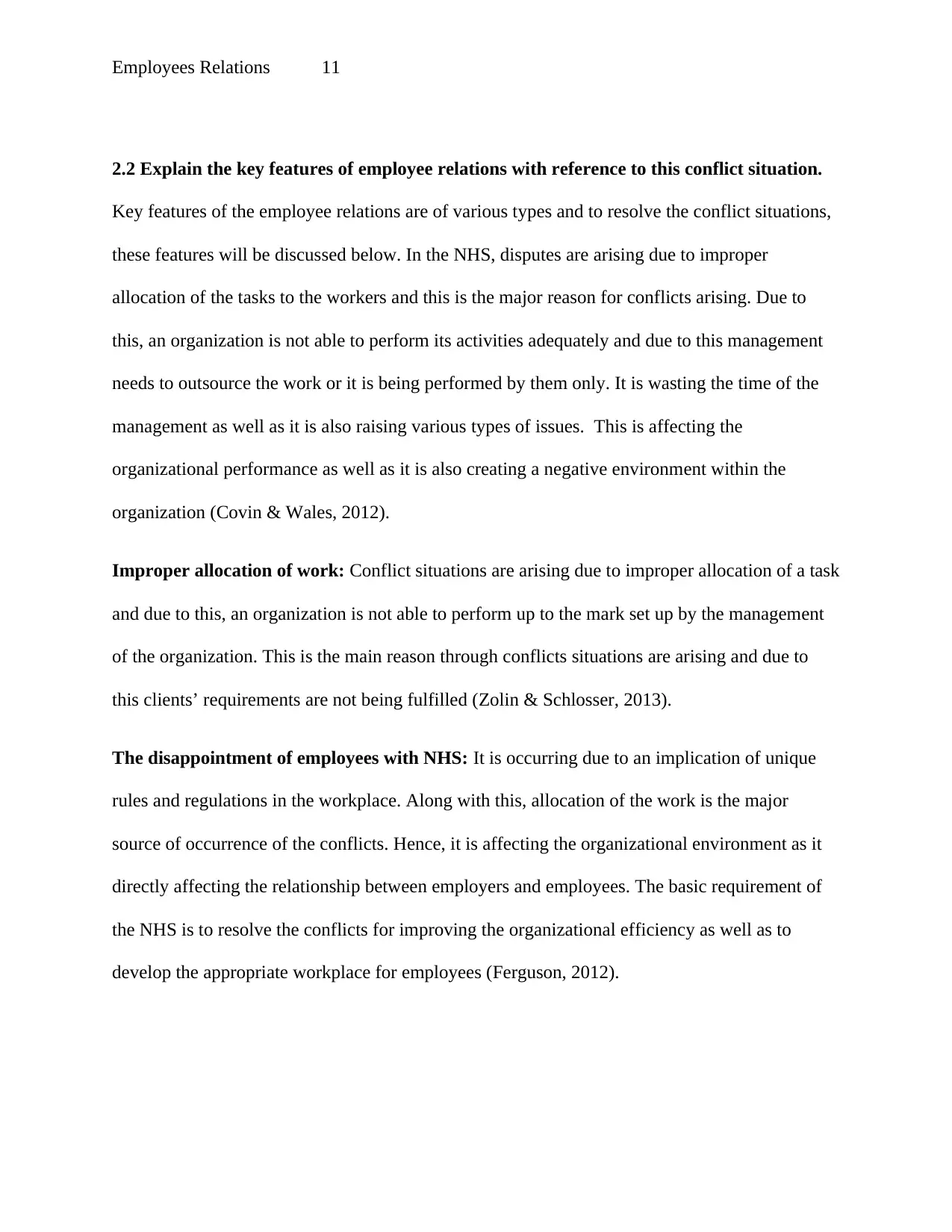
Employees Relations 11
2.2 Explain the key features of employee relations with reference to this conflict situation.
Key features of the employee relations are of various types and to resolve the conflict situations,
these features will be discussed below. In the NHS, disputes are arising due to improper
allocation of the tasks to the workers and this is the major reason for conflicts arising. Due to
this, an organization is not able to perform its activities adequately and due to this management
needs to outsource the work or it is being performed by them only. It is wasting the time of the
management as well as it is also raising various types of issues. This is affecting the
organizational performance as well as it is also creating a negative environment within the
organization (Covin & Wales, 2012).
Improper allocation of work: Conflict situations are arising due to improper allocation of a task
and due to this, an organization is not able to perform up to the mark set up by the management
of the organization. This is the main reason through conflicts situations are arising and due to
this clients’ requirements are not being fulfilled (Zolin & Schlosser, 2013).
The disappointment of employees with NHS: It is occurring due to an implication of unique
rules and regulations in the workplace. Along with this, allocation of the work is the major
source of occurrence of the conflicts. Hence, it is affecting the organizational environment as it
directly affecting the relationship between employers and employees. The basic requirement of
the NHS is to resolve the conflicts for improving the organizational efficiency as well as to
develop the appropriate workplace for employees (Ferguson, 2012).
2.2 Explain the key features of employee relations with reference to this conflict situation.
Key features of the employee relations are of various types and to resolve the conflict situations,
these features will be discussed below. In the NHS, disputes are arising due to improper
allocation of the tasks to the workers and this is the major reason for conflicts arising. Due to
this, an organization is not able to perform its activities adequately and due to this management
needs to outsource the work or it is being performed by them only. It is wasting the time of the
management as well as it is also raising various types of issues. This is affecting the
organizational performance as well as it is also creating a negative environment within the
organization (Covin & Wales, 2012).
Improper allocation of work: Conflict situations are arising due to improper allocation of a task
and due to this, an organization is not able to perform up to the mark set up by the management
of the organization. This is the main reason through conflicts situations are arising and due to
this clients’ requirements are not being fulfilled (Zolin & Schlosser, 2013).
The disappointment of employees with NHS: It is occurring due to an implication of unique
rules and regulations in the workplace. Along with this, allocation of the work is the major
source of occurrence of the conflicts. Hence, it is affecting the organizational environment as it
directly affecting the relationship between employers and employees. The basic requirement of
the NHS is to resolve the conflicts for improving the organizational efficiency as well as to
develop the appropriate workplace for employees (Ferguson, 2012).
⊘ This is a preview!⊘
Do you want full access?
Subscribe today to unlock all pages.

Trusted by 1+ million students worldwide
1 out of 26
Related Documents
Your All-in-One AI-Powered Toolkit for Academic Success.
+13062052269
info@desklib.com
Available 24*7 on WhatsApp / Email
![[object Object]](/_next/static/media/star-bottom.7253800d.svg)
Unlock your academic potential
Copyright © 2020–2025 A2Z Services. All Rights Reserved. Developed and managed by ZUCOL.





